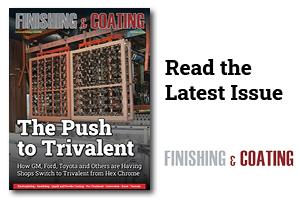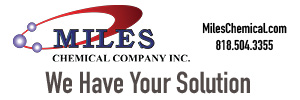As we close 2024, the Metal Finishing Champions Group (MFCG ) of the City of Los Angeles Sanitation and Environment (LASAN) wishes all metal finishers within the city a prosperous 2025.
 Miguel RodasThe MFCG recognizes the metal finishing sector as important in the city's economy. Recently, just before Christmas, we had the honor of interacting with some shop owners in our city. I was glad to see, feel, and realize their open-door policy. We had the opportunity to shake hands with personnel. The regulatory presence and the open-door policy have provided the opportunity to advance and promote environmental compliance, source control, and pollution prevention (P2) to metal finishers. The past confrontational culture has changed to a more cooperative culture. So, by establishing a channel, a bridge, we continue our job to inform and educate. While we do not have a crystal ball, we attempt, in what follows, an essay summary of what the MFCG foresees happening in 2025, especially at the regulatory level.
Miguel RodasThe MFCG recognizes the metal finishing sector as important in the city's economy. Recently, just before Christmas, we had the honor of interacting with some shop owners in our city. I was glad to see, feel, and realize their open-door policy. We had the opportunity to shake hands with personnel. The regulatory presence and the open-door policy have provided the opportunity to advance and promote environmental compliance, source control, and pollution prevention (P2) to metal finishers. The past confrontational culture has changed to a more cooperative culture. So, by establishing a channel, a bridge, we continue our job to inform and educate. While we do not have a crystal ball, we attempt, in what follows, an essay summary of what the MFCG foresees happening in 2025, especially at the regulatory level.
The interaction between owners and MFCG has always been positive, which has allowed the promotion and enforcement of the statutes of the Clean Water Act. Yet, our approach has been friendly, educational, and informative. This interaction has produced a mutual empathic, friendly relationship. Indeed, it takes one visit to a plating shop to realize that only through the magic of chemistry can metal finishes give back a new life to metal parts. Because metals in the presence of air, oxygen, humidity, water, and other diverse environments lose their strength, they collapse and turn to metal oxides or rust. Oxidation, thus, degrades and destroys. Yet, metals are rescued, restored, and protected against this natural enemy—oxidation. Our message is that society needs to learn to recognize the economic value that the surface finishing sector offers to society—protecting metals against corrosion, enhancing their physical properties, and increasing their life span.
Economic Importance of Metal Finishing
We started the gathering with metal finishers in 2018. We first failed to meet in 2024 because our division manager, Michael Simpson, retired, and so did the leadership of IWMD. Yet past gatherings have had the desired positive effect on the MFCG. One of the things we learned, as a group, is the economic value of metal finishing cited above. It is incredible how a natural process, corrosion, could be enemy number one of mankind. Oxidation affects metals and humans as well. We age with time, right? Yes, we oxidize and corrode, but skin oxidation looks different). So, if we look closer at our surroundings—the bridges around us, machinery, and tools, we see (or may not) structural fatigue due to oxidation. So clear is the economic importance of metal finishing, as explained in the January 2022 issue of the National Transportation Safety Board, which reported that the collapse of the Fern Hollow Bridge was due to a structural failure involving corrosion.
Furthermore, research has shown how the “loss of productivity due to deteriorated infrastructure and the loss of full operational capability for industrial and military equipment and facilities” proves that corrosion destroys (Research Opportunities in Corrosion Science and Engineering, 2011, p. 3). Corrosion will not disappear anytime soon. So, one important question is: Have we (as a society) failed to realize the importance of metal finishing? Or has the government ignored its economic value?
So, let us venture into predicting what will happen and will continue to happen at the regulatory level in the metal finishing sector. More than predicting is an educated guess. We know that California has always imposed more stringent environmental regulations than the federal government, but banning an industry that positively contributes to our modern life by protecting infrastructure against the devastating effects of corrosion is a myopic perspective. Its economic value was underestimated when the state approved the due dates for the progressive phase-out of hex-chrome in metal finishing operations. So, even when knowing the valuable contribution of metal finishing to society, their regulatory march continues. So where is the problem? Is it us, the customers, or is it the government?
Main Drivers Pushing for More Regulations
The main drivers pushing for more regulations have always been the grassroots organizations that keep the pressure on the federal and the state. Just recently--and we know of it, the California Air Resources Board (CARB) passed a ruling against decorative and electroplating using hexavalent chromium (Hex-Chrome). Part of the proposed ruling includes adopting the new chromium III (Tri-Chrome) as a green, safer alternative chemistry and healthier and friendly alternative for humans. During a field inspection, we learned that some metal finishers had already informed the state that they were embracing the tri-chrome and moving away from the hex-chrome. But “selling Tri-chrome is not that easy,” they said. In fact, “some clients, especially among auto/motorcycle restorers, do not accept the quality,” they said. The point is that instead of banning existing processes, the government and research science must do more work to develop new, cleaner, safer, greener chemistries, not by putting companies out of business. One may interpret that metal finishers are forced to transition without the right, safe alternatives and associated technology to embrace it. Let us set the cart and horse in the right place.
Legislation against metal finishing may be intensified (or not in the future). This will depend on the new president. In the Nov/Dec news from NACWA, we discovered that the EPA (still under Biden) has introduced a new method for PFAS testing. Method 1633A is expected to be promulgated and published in 40 CFR Part 136. Historically, after a test method is published, the next step is promulgating PFAS discharge limitations. Historically, metal finishers used fume suppressants that contained some of the PFAS for screening. There is good news, nonetheless. An exceptional development occurring now is the research work funded by the NASF to break or destroy PFAS. Yes, science and technology always go hand in hand. So treatment technology to destroy PFAS is in the making: Electrocoagulation, special ion exchange resins, nanofiltration, etc., which transfers PFAS only from one medium to another. So, the next technological treatment system will include photolytic techniques and photochemical thermal oxidation. Sounds costly; you bet. So, what may come next? Considering the pro-industry perspective of the new president, it is not difficult to predict what is next. In its Strategic Road Map, EPA—under the Biden administration, describes the plan to tackle PFAS. Under the Trump administration, that may not even make it to Congress. What do you think?
Extensional Fatalistic Connotations
On another front, while the news that chromium emissions affect workers and the communities around facilities engaged in metal finishing types of facilities continues, the news will always be tainted with extensional fatalistic connotations, creating maps that do not correspond to (real) territories. Maps do not always correspond to local territories or the local realities. The menu is not the meal. Words never say all about anything. So, intentionally creating hex-chrome toxic clouds above the neighborhoods and blaming a particular singular industrial sector is deceiving and irresponsible. Pollution comes from all fronts: Traffic, natural disasters, climate change, and industry.
Yet, despite the increased regulatory scrutiny, the Surface Finishing sector has managed (so far) to survive by complying with existing air regulations, reducing hex-chrome emissions by introducing control technology, progressively introducing new process substitution, and adopting and implementing pollution prevention (P2) practices. Of this trend and progress, the MFCG has been evaluating P2 practices, water conservation, and adapting to the ever-changing regulatory landscape. We take the opportunity to celebrate the metal finishers that prioritized environmental compliance but also embraced source control, P2, and Green Chemistry (GC) in some of their operations. We also take the opportunity to acknowledge their presence in celebrating Earth Day with LASAN in 2024. We wish them to thrive in the long term.
As humans, citizens, or customers, are we affected by all the above? Yes, metals also form part of our body. We are terrestrials. Metals such as iron, copper, calcium, sodium, nickel, zinc, and chromium form part of the human body. They are also on Earth’s surface (Genchi, Lauria, Catalano, Carocci, and Sinicropi, 2021). Metals have also made our modern life possible (think about your phone). Chromium, for example, exists in different oxidation states in nature, with trivalent (III) and hex-valent (VI) the most common ones. While chromium III plays a major role, as a trace mineral, in human health, chromium VI has been established as a carcinogen, which exposure occurs “in occupational and environmental contexts” (Genchi, Lauria, Catalano, Carocci, and Sinicropi, 2021). However, metal finishers are not only aware of this fact but have also introduced control technology to comply with air emissions and reduce occupational exposure. What is the future of metals in society?
Metals Are Necessary to Bring Progress to Society
The National Academies of Sciences, Engineering, and Medicine considers that the corrosion field is set to “make huge leaps in the future” (Council, 2011, p. vii). The NRC believes that “our quality of life is increasingly dependent on the preservation of metals.” The federal directives are heading the way not only to invest, replace, and protect infrastructure made of metal but also the societal expectation for the continued improvement of life in all dimensions (including AI). Suppose we are to recognize the economic value of metals. We must ask: Is the existence of metals necessary to bring progress to society? Absolutely.
Now, let us consider the subject matter as consumers. Some of the questions on your mind include: Are we shifting to plastics, new unknown nanomaterials that will also bioaccumulate? Does this mean a progressive increase in the price of home appliances or vehicles of lesser quality? Or, from a safety point of view—are we supposed to question the integrity of a bridge, or a plane, before we get into it? We believe that progress for mankind launched when mankind started to work with metals. The Bronze Age started when stone tools were replaced with good-looking metal tools. Are we heading back to the stone age? Are we headed to accept and live with lesser-quality materials? Or are we being forced to accept a reality based on false premises about pollution? Finally, we have unprecedented conditions to deal with and adjustments to make. But first, we must create an unprecedented attitude of mind to cope effectively with whatever unprecedented conditions we face. Happy New Year 2025 to Metal Finishers in LA. We hope you are thriving in the long term.
Miguel Rodas is Senior Environmental Compliance Inspector for the Los Angeles Sanitation, Industrial Waste Management Division, Metal Finishing Sector Champions Group, Edward Calleros, Clifford Chang, Ernesto Lozano, Jan Marte, Brian Castellon, and Miguel Rodas.



































